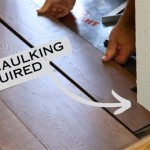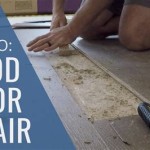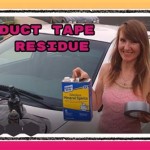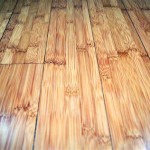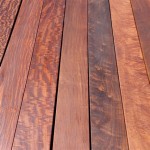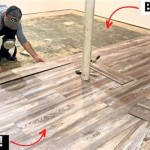How To Fix Laminate Wood Floor Water Damage
Laminate flooring, a popular choice for its affordability and aesthetic appeal, is not immune to the detrimental effects of water damage. Understanding the causes, identifying the signs, and implementing appropriate solutions are crucial for preserving the integrity and appearance of laminate floors. While laminate floors offer a degree of water resistance, prolonged exposure or significant spills can lead to warping, swelling, and even mold growth. This article provides a comprehensive guide on how to address water damage in laminate flooring and prevent future occurrences.
It is important to differentiate between water-resistant and waterproof. Laminate flooring is generally water-resistant, meaning it can withstand minor spills for a short period if promptly cleaned. However, it is not waterproof and cannot tolerate standing water or prolonged exposure to moisture. The core of most laminate flooring is made of high-density fiberboard (HDF) or medium-density fiberboard (MDF), which are highly susceptible to water absorption. Once water penetrates the surface, it can cause the core to swell, buckle, and delaminate.
The severity of water damage to laminate flooring depends on several factors, including the duration of exposure, the source of the water, and the quality of the flooring. Minor spills that are quickly cleaned are unlikely to cause significant damage. However, leaks from appliances, plumbing issues, or flooding can result in extensive and costly repairs. Early detection and prompt action are essential to minimizing the damage and preventing long-term issues.
Identifying Water Damage in Laminate Flooring
Recognizing the signs of water damage early is crucial for implementing timely repairs and preventing further deterioration. Several indicators can alert individuals to potential water damage in laminate floors. These signs can range from subtle changes in appearance to more obvious structural issues.
One of the first signs of water damage is often the appearance of discoloration or staining on the surface of the laminate. This may manifest as dark spots, streaks, or a general fading of the floor's color. These discolorations are typically caused by water penetrating the surface layer and affecting the underlying materials. Pay close attention to areas near sinks, toilets, dishwashers, and refrigerators, as these are common sources of leaks.
Another common sign of water damage is warping or buckling of the laminate planks. When the core of the laminate absorbs water, it expands, causing the planks to lift and become uneven. This warping can be subtle at first but will worsen over time if left untreated. Inspect the seams between planks for any signs of lifting or separation. If the seams are no longer flush, it is a strong indication of water damage.
Swelling is another key indicator of water damage. As the core material absorbs water, it expands, causing the planks to swell in thickness. This swelling can make the floor feel spongy or uneven when walking on it. In severe cases, the swelling can be significant enough to cause the planks to crack or break. Pay particular attention to areas along walls and under appliances, where water is likely to accumulate.
A musty or moldy odor can also indicate water damage, even if visible signs are not immediately apparent. Mold and mildew thrive in damp environments, and their presence suggests that water has been trapped beneath the flooring for an extended period. If a musty odor is detected, it is important to investigate further to determine the source of the moisture and address any underlying mold growth. This may involve removing sections of the flooring to inspect the subfloor.
Finally, changes in the sound of the floor when walked upon can also indicate water damage. If the floor sounds hollow or creaky in certain areas, it may be due to the underlying support becoming weakened by water exposure. Compare the sound in different areas of the room to identify potential problem spots. Areas that sound significantly different from the rest of the floor should be investigated further.
Steps to Take Immediately After Water Damage
Prompt action after discovering water damage is critical to minimizing the extent of the problem and preventing further complications. The initial steps taken can significantly impact the long-term outcome of the repair process.
The first and most important step is to identify and stop the source of the water. This may involve turning off a leaking faucet, repairing a broken pipe, or addressing a faulty appliance. Delaying this step will only exacerbate the problem and increase the amount of damage. Once the source is identified, take steps to prevent further water from entering the affected area. This might involve patching a roof leak temporarily or diverting water away from the building's foundation.
Next, remove any standing water as quickly as possible. Use towels, mops, or a wet/dry vacuum to remove the water from the surface of the laminate flooring. Pay particular attention to corners, edges, and seams, as these areas are more prone to water accumulation. The faster the water is removed, the less likely it is to penetrate the flooring and cause further damage. Dispose of any water-soaked materials, such as rugs or furniture, to prevent mold growth.
Increase ventilation in the affected area to promote drying. Open windows and doors to allow for natural airflow. Use fans to circulate air and speed up the drying process. Dehumidifiers can also be used to remove excess moisture from the air. The goal is to create an environment that discourages mold growth and allows the flooring to dry thoroughly. Positioning fans to direct air flow along the floor surface can significantly speed up evaporation.
Remove any furniture or objects from the wet area to prevent further damage. The weight of furniture can trap moisture and exacerbate warping or swelling. Lift furniture onto blocks or covers to prevent it from coming into contact with the wet floor. This will also allow for better airflow and faster drying. Ensure that any electrical appliances are disconnected before entering the area to prevent electrical hazards.
Document the damage for insurance purposes. Take photographs and videos of the affected area, including any visible signs of water damage. Keep records of all expenses related to the cleanup and repair process. Contact the insurance company as soon as possible to file a claim. Providing detailed documentation will help to expedite the claim process and ensure that you receive adequate compensation for the damages.
Repairing Water Damaged Laminate Flooring
The process of repairing water-damaged laminate flooring varies depending on the severity and extent of the damage. Minor water damage may be repairable with simple techniques, while more extensive damage may require professional intervention or complete replacement of the affected flooring.
For minor spills or surface water damage, the first step is to thoroughly dry the affected area. Use towels, mops, or a wet/dry vacuum to remove any standing water. Then, use a fan or dehumidifier to dry the area completely. This may take several days, depending on the humidity levels. Monitor the area closely for any signs of warping, swelling, or discoloration. If no significant damage is apparent, the flooring may recover on its own. Ensure the area is well-ventilated during the drying process to prevent mold growth.
If the laminate planks are slightly warped or buckled, it may be possible to flatten them using weight. Place heavy objects, such as books or furniture, on the affected area to apply pressure. Cover the planks with a protective material, such as towels or cardboard, to prevent scratching. Leave the weight in place for several days, or even weeks, to allow the planks to gradually flatten. This method is most effective for minor warping and may not work for more severe damage. Monitor the planks closely for any signs of cracking or further damage.
For more significant water damage, it may be necessary to replace the affected planks. Carefully remove the damaged planks using a pry bar or other appropriate tool. Be sure to avoid damaging the surrounding planks or the subfloor. Clean the subfloor thoroughly and allow it to dry completely. Install new planks that match the existing flooring. Ensure that the new planks are properly aligned and secured. Use a tapping block and hammer to gently tap the planks into place. Replacing individual planks can often be done with relative ease if the damage is localized.
In cases of extensive water damage or mold growth, it is advisable to hire a professional flooring contractor or water damage restoration specialist. These professionals have the expertise and equipment to properly assess the damage, remove affected materials, and restore the flooring to its original condition. They can also address any underlying issues, such as mold growth or structural damage. Hiring a professional can ensure that the repairs are done correctly and that the flooring is properly protected against future water damage. This is a worthwhile investment to prevent more costly repairs down the line.
To prevent future water damage, take proactive measures to protect the laminate flooring. Apply sealant along seams and edges to prevent water from penetrating. Place mats at entrances to trap dirt and moisture. Clean up spills immediately to prevent water from soaking into the flooring. Regularly inspect plumbing fixtures and appliances for leaks. Taking these preventative steps can help to extend the life of the laminate flooring and minimize the risk of water damage.

How To Prevent Repair Water Damage Laminate Flooring Claude Browns

A Guide To Fix Wet Laminate Floors All Dry Usa

How To Repair Laminate Flooring With Water Damage Dry Force

How Do I Repair My Wood Floor After A Flood

How To Fix Laminate Floor Water Damage Nut

Step By Guide On How To Fix A Laminate Floor That Got Wet

Repair Or Replace Water Damaged Floors 50 Floor

A Quick And Easy Way To Repair Buckled Hardwood Flooring

Why Am I Being Told That My Waterproof Laminate Flooring Needs To Be Pulled Up After Water Damage Restopros Of Northeast Georgia

Tips To Fix Laminate Floor Bubbling
See Also

